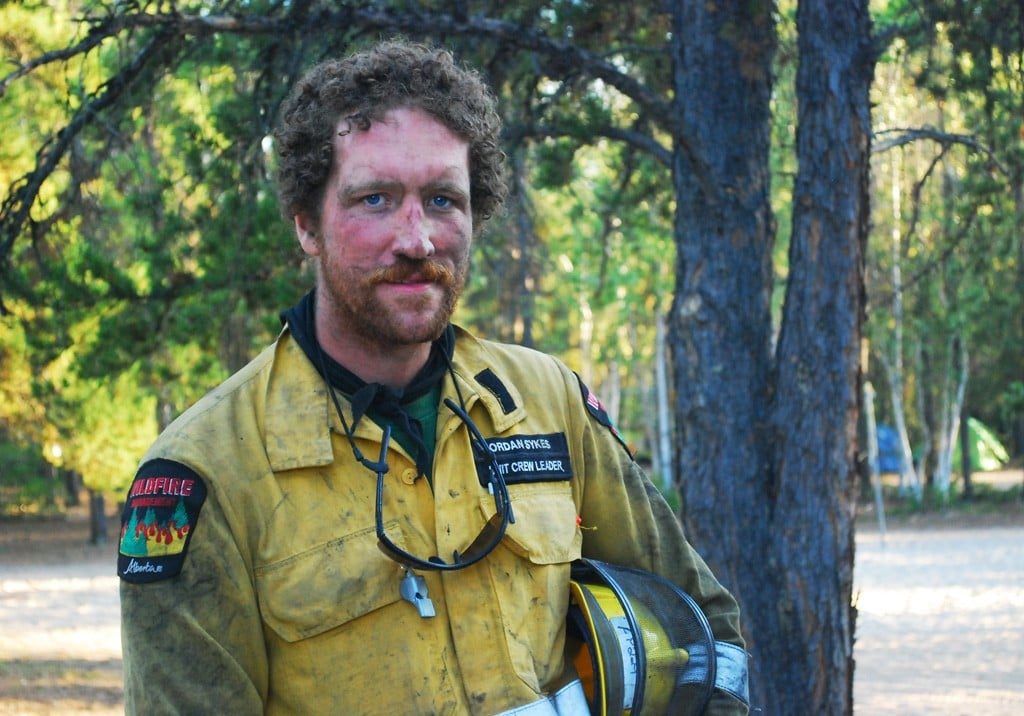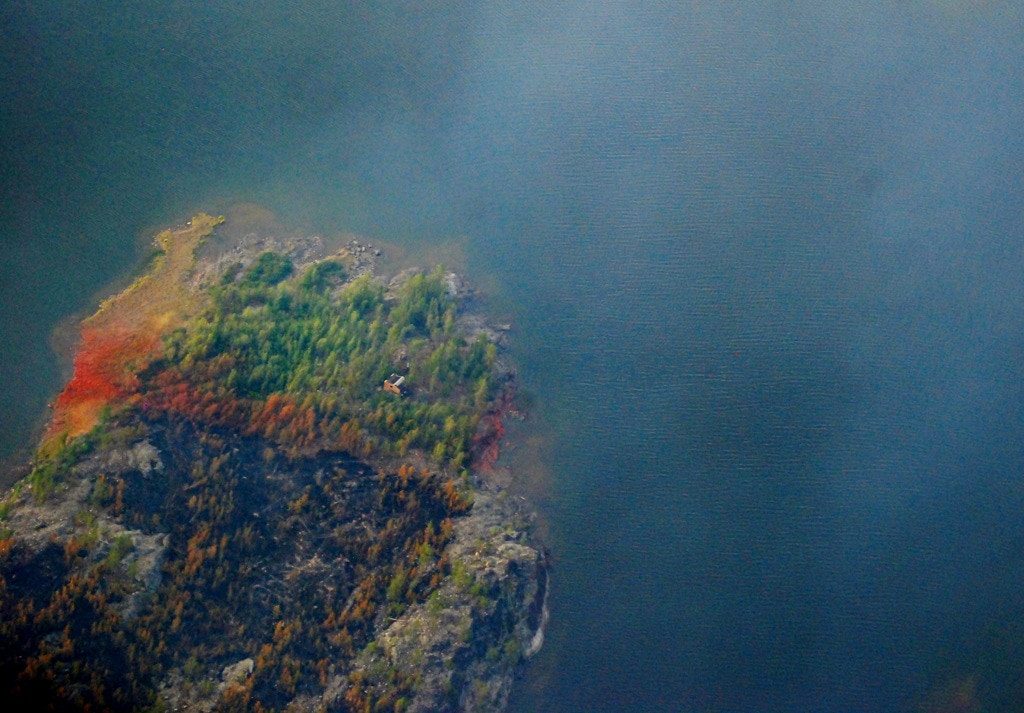A cabin saved with surgical precision | Photos and video by Peter Mothe
From the safety of a helicopter, Fire ZF-014 looks unimpressive, a monotonous black stain, interrupted only by lakes and the occasional sighting of smoke plumes.
But as my movable perch circles around the burned out areas, I begin to wrap my head around the size of the fire, now estimated to be 32,000 hectares.
That’s 12,000 hectares larger than it was a week ago, when it forced the evacuation of Reid Lake Campground and a closure on Highway 4, about 50 km east of Yellowknife.
But despite its growth, there’s a lot of work being done on ZF-014, and from my vantage point I can see the scale and success of that work. So far, all 27 cabins have been saved, including a couple of close calls that were resolved with near-surgical precision.
As the helicopter begins its descent onto the Reid Lake Campground, which has become the operational base for the ENR team, I begin to wonder if I would even be in this helicopter, 12,000 kilometres away from home, had I encountered such professional firefighters a couple of years ago.
***
In September of 2013, I was living out a childhood fantasy in the Sierras Chicas of central Argentina. For the past year, my life had been idyllic and trouble-free. I lived in a quaint little cabin surrounded by ancient forests and trickling streams, and felt like I had found my place in the world.
But all that was lost one windy morning.
The plumes of smoke, which for the past two days had been visible over the horizon, had seemed distant and unthreatening, until changing winds swung the fire east on a destructive path towards my cabin.
Fed by dry conditions and increasingly strong winds, the fire roared through the old-growth forest, arriving at my cabin several minutes before any firefighter.
And just like that, my life was turned upside-down.
What came next were days of utter chaos, not only for myself, but also for the whole community of the Sierras Chicas. With only a handful of trained men in the force, firefighters were completely overwhelmed. Neighbors, self-organized in what came to be known as the “hippie brigades,” did their best to stop the advance of the fire, but often got in the way of professionals. Structure and command were non-existent, and I’ll never forget the image of a group of neighbors trying to transport water to the front lines in a bathtub on the bed of their truck.
A week after the fire started, heavy rains and support from out-of-province firefighters allowed for a proper operation to be put in place, but by the time all was said and done, 95,000 hectares of forest, farmlands, and homes, including my own, had been burned to the ground.
Now, nearly two years later, I’m sitting in a helicopter, descending into yet another fire zone.

Mapping Fire ZF-014 from the sky
***
The situation at Reid Lake is as far from chaotic hippie brigades as possible. The campsite is highly organized, and operations seem to be running smoothly. Frank McKay, an ENR handler assigned to guide a group of four journalists through the campground, provides the best description of the scene.
“It’s like a military approach we’re taking,” McKay said, as he walked us through the ENR command centre, where the operations team, led by incident commander Lawrence Louis, organizes resources and defines daily objectives.
These objectives, along with important information on weather and wind patterns, are printed daily in a document called the Incident Action Plan, which is distributed to the crews every morning.
“The IAP changes from day to day depending on weather, rain, and resources,” McKay said as he went over the document page-by-page. He said that the document is a great way to keep people safe and informed, but that it must be fluid, as things can change quickly during a fire.
And things often change. For example, burnout operations planned for Tuesday at Defeat Lake had to be cancelled due to unfavorable winds. That would obviously be added to the next day’s report, as well as the fact that a group of journalists had visited.
The attention to detail makes McKay confident that the fire doesn’t pose too many dangers to man-made structures.
McKay is just one of over 100 people currently based out of Reid Lake campground working on the fire. That includes 75 firefighters, a handful of airplane and helicopter pilots, and support and administrative staff.
Amongst those people is Stew Walkinshaw, the man in charge of keeping people’s cabins safe.
Walkinshaw, whose official title is values-at-risk specialist, says his job is made easier by the GNWT’s FireSmart and mapping programs.
“The NWT has a really robust database of where all the values are on the landscape so we can look on maps, and we can see where everything is located out there,” said Walkinshaw, who worked as a municipal fire fighter in Canmore, AB, before focusing on forest fires in 1993.
His job is to prioritize which structures are most at risk, and then deploy systems to keep them safe. To do that, he and his crew fly out several times a day to the 27 cabins that have already been protected around Reid, Peninsula, Terry, and Little Pickerel lakes. Once at the cabins he makes sure they’re all safe, and sees what’s needed to prevent them from burning.
A defense system is then deployed based on the needs of each cabin, with measures that include anything from installing sprinklers and pumps, to moving firewood away from structures, or even deploying controlled burns in areas adjacent to the cabins.
“We’ve had three or four close calls, but all have been really successful so far,” said Walkinshaw, adding that there are plans to protect 14 more cabins in the next few days.

Firefighter Jordan Sykes loves his job
While Walkinshaw and his crew protect structures, Jordan Sykes, 29, fights the fire on the ground.
Originally from Edmonton, Sykes is part of the group of 40 firefighters that flew up from Alberta less than a week ago to help fight Fire ZF-014. He says that the fire season has slowed down in his home province, giving his crew the opportunity to come to the NWT.
“I’m glad my crew gets to come up here and see what it’s like up here,” said a grime-covered Sykes, who’s in charge of 20 firefighters and spent Tuesday battling heavy winds to contain the fire’s expansion.
“Containment has been really good,” Sykes said. “We’ve been holding [the fire].”
The 29-year old started fighting forests five years ago as a summer job. Now, he’s hooked.
“I love it,” he said. “I’m studying forestry in school and I want to keep on doing it.”
Even though he’s spent his days in the NWT working on the front lines of a fire, he still manages to appreciate the region’s scenery: “Everyone on the crew is enjoying how beautiful it is.”
***
Back on the helicopter, incident commander Lawrence Louis, asks Seiji Suzuki, our helicopter pilot, to fly over an area of concern close to Harding Lake. He’s not only doing it so we can get shots of one the fire’s most active spots, but because he needs to map out the fire’s advance to include it in tomorrow’s Incident Action Plan.
It’s just past 8 pm, and although most crews have been demobilized for the night, there’s another helicopter doing rounds. As I see these professional firefighters at work, I’m once again infused with a sense of safety.
I don’t think there will be a need to call the hippie brigades out to Yellowknife.

Some of the 32,000 hectares currently involved
How are cabins around Reid Lake being protected from forest fires? from petermothe on Vimeo.







